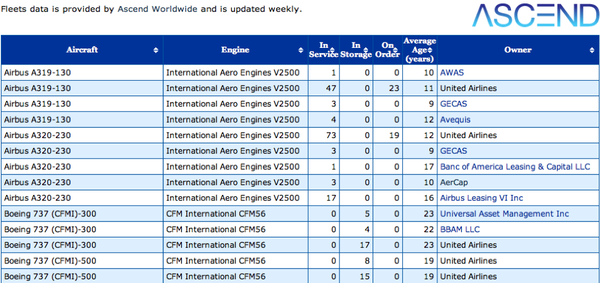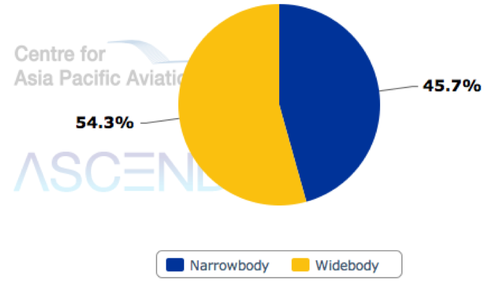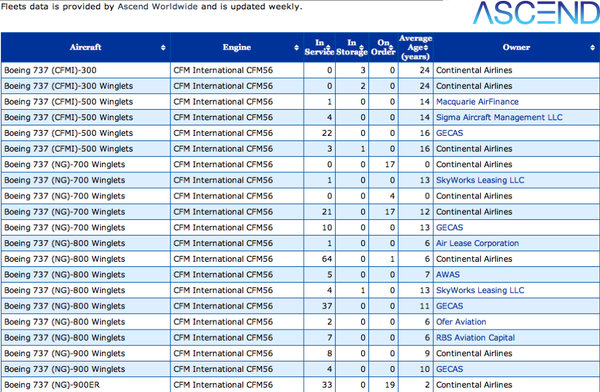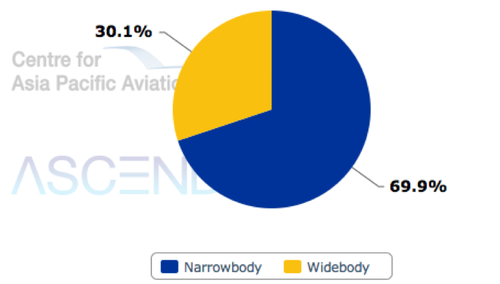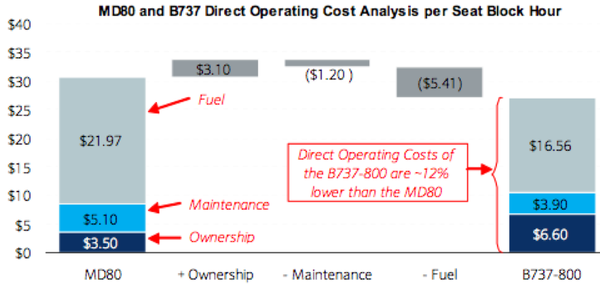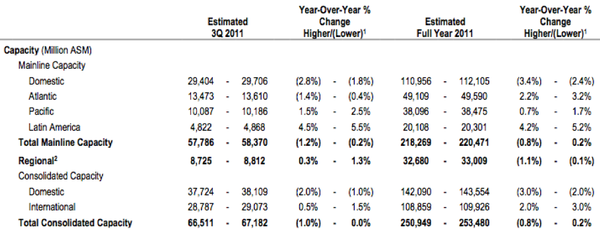United Airlines' profits down year on year
In what is turning out to be the story for this earnings season, United posted declining profits on rising revenues, with US Airways following close on its heels with the same results. Alaska, however, posted its fifth consecutive quarter of profitability.
The other story was reflected in CEO Jeff Smiseks description of the tepid economy and its actions to reduce capacity.
United Continental Holdings posted a 12% drop in profits during the second quarter when net profits reached USD538 millions on a GAAP basis. The results came as it also reported a 10.3% increase in revenues to USD9.8 billion and a 12.1% increase in operating expenses to USD9.1 billion.
The profits kicks off what is expected to be a long line of profitability reports in the sector over the next two weeks following the raising-revenues, falling-profits trend.
The second quarter pretax income represented a 6% pretax margin, up from the past 12 months when it was 4.2%. But, return on invested capital was 12%, exceeding our cost of capital.
For United/Continental Holdings, analysts were expecting USD1.47 per share and the company beat that at USD1.49. It also beats analyst estimates for revenue at USD9.8 billion compared with consensus expectations of between USD9.64 billion and USD9.96 billion. Although May revenues were better than expected, May and June traffic were down 0.3% and 0.9%, respectively, illustrating the state of the market. Soleil securities has it as a buy with a target price of USD39, up from its USD36 expectation, according to Ticonderoga analyst James Higgins.
The airline cited weather as well as the continuing Japanese crisis for the results and the fact that yields were slowing in June.
It reported an interesting trend with its ancillary revenue. Ancillaries rose only modestly on strong growth in value-added products and services. However, its frequent flyers and co-branded credit card users, whose bags fly free, diluted ancillaries even as they contributed to revenue growth through fares.
Analysts expressed concern about moves in Washington to tax ancillaries and Mr Smisek responded by saying any time Congress is in session the industry is at risk. He reiterated the industry's position saying the industry is "brutally over taxes", more heavily than alcohol, tobacco and firearms.
"We're always at target," he concluded. "We hope that given the over-taxation and all the regulations to this industry that they won't tax us even more and we'll be of course working hard to prevent that."
Comparative statistics to date
|
2Q 2011 vs 2101 |
ALK |
AMR |
DAL |
HA |
JBLU |
LUV |
UAL |
LCC |
ALGT |
|---|---|---|---|---|---|---|---|---|---|
|
Profit USD |
28.8 down 50.9% |
(286M) v (11M) |
Yet to report |
Yet to report |
Yet to report |
Yet to report |
538M down 11.9% |
92M vs 279M |
Yet to report |
|
Op Revs USD |
1.1B up 13.7% |
6.114B up 7.8% |
9.8B up 10.3% |
3.5B up 10.5% |
|||||
|
Op Exp USD |
1B up 21.5% |
6.192B up 13% |
9B up 12.1% |
3.3B up 18.8% |
|||||
|
ASMs |
7.4B up 7.2% |
39.2B up 2.1% |
56.4B up 1.1% |
19.1B up 3.3% |
|||||
|
LF |
84.3 up 2.4 pts |
83.6% down 0.3 pts |
84% down 0.9 pts |
83.8% up 0.9 pts |
|||||
|
Yield Cents |
14.39 up 3.9% |
13.90 up 4.6% |
14.46 up 10.3% |
16.30 up 6.5% |
|||||
|
Prasm Cents |
13.58 up 6.8% |
11.62 up 4.9% |
12.15 up 9.1% |
13.66 up 7.6% |
|||||
|
CASM Cents |
NA |
14.52 up 9..8% |
12.97 up 10.7% |
14.59 up 15% |
|||||
|
CASM ex fuel/ Cents |
8.46 down 3.1% |
9.36 up 1.4% |
8.17 up 3% |
9.14 up 0.9% |
|||||
|
Anc/Other Revs USD |
66.9 up 7.4% |
659M up 5.5% |
780M up 0.9% |
345M up 3.9% |
Reaction to American order
American's large aircraft order is not prompting any of its peers to panic. US Airways, United and Alaska weighed in during earnings calls yesterday all reporting they are happy with their order books. In addition, all expressed confidence that the size of American's financing and its delivery positions would not preclude them from getting aircraft or from tapping financial markets at good rates.
As with its counterparts at Alaska and US Airways, United executives welcomed Boeing's decision to re-engine the 737. However, United echoed others in saying it is too early to tell whether they'd be interested. However, US Airways CEO Doug Parker indicated it would take a lot to move it to consider a purchase.
"We are currently happy with our fleet plan," said Mr Parker echoing his counterparts. "We have one of the youngest fleets behind United and Continental and we are getting younger as we retire our 737s and bring in the A320s and A321s and we are certainly not looking for airplanes for growth. Boeing's decision doesn't change much for us. If the manufacturers build aircraft that reduces our operating costs large enough to spend the capital then we are all in but, so far, no one has come close."
United narrowbody fleet/orders
Even so, a look at the United narrow-body fleet show its 737 fleet age exceeds 20 years while its Airbus fleet is between nine and 17 years. It has 23 A320s on order along with 19 A319s. Continental's fleet includes five 737-300s with and without winglets in storage. It is operating about 237 737s of varying ages. Continental also has another 54 on order.
CEO Jeff Smisek said the company has solid narrow- and wide-body orders with a lot of the fleet coming off lease over the next four years. He indicated that gives it a lot of fleet flexibility which American's order does not change. The company continues to evaluate fleet integration and needs but is not ready to make a fleet plan at this point in the integration.
United Airlines fleet breakdown for aircraft in service (at 18-Jul-2011)
United Airlines fleet breakdown for aircraft on order (at 18-Jul-2011)
Continental fleet/orders
Continental Airlines fleet breakdown for aircraft on order (at 18-Jul-2011)
It is likely United, US Airways and Alaska are thinking along the same lines as Barclays Capital which issued a research note yesterday on the American order.
Barclays Capital called it a bold move but noted things remain dismally the same at the Dallas-based carrier. Expressing disappointment, Barclays would have preferred its fleet plans be accompanied by a more comprehensive plan to restore profitability in the near-term. It continued to recommend the carrier as an option play but certainly nothing else since the we "unfortunately don't yet see evidence AMR will stop underperforming the industry. As a result, we don't see today's order changing much over the next few years."
That must be frustrating to the C Suite in Dallas given the order's promise to reduce fuel costs by 35% over its current fleet. Analysts indicated United's seat-mile-per gallon was 66 last year for both United and Continental, nearly 7% more than American's 61.8 seat-miles-per-gallon at the mainline. Delta bested American by 5.1% at 64.9 while Southwest was the industry leader at 68.5, nearly 11% more than American.
"New aircraft sound great, but they carry a number of costs," said Barclays, which immediately discounted the planned fleet-age decline. "The promise of fuel and maintenance savings can be rather appealing. Unfortunately, they don't come free. In this case, the costs will be higher ownership expenses, more fixed, versus variable, cost, and larger aircraft, which likely cannot be deployed one for one without RASM dilution. Our analysis suggests net savings, but not nearly what fuel burn alone would suggest. Perhaps this order will make AMR's fleet the best among peers in five years, but it is likely to leave AMR with the highest leverage at the same time (regardless of how much cash changes hands upon deliveries)."
Substantial Operating Savings, but with Meaningful Offset from Ownership Costs
United/Continental outlook
United reported a consistent demand environment ahead, adding demand with corporate accounts is business as usual tied to growth rather than cutting back or increasing.
However, the National Association for Business Economists survey showed 43% of respondents to a recent survey expect to add jobs in the next six month, outstripping all previous expectations over the last year. That should translate into more business but airline executives reporting this week could only express cautious optimism about the future.
The carrier is not expecting to reach labor agreements this year simply as it has planned because a number of groups have yet to decide which union will represent them. Despite the fact that pilots are both represented by ALPA, talks are going slow.
Mr Smisek responded to a question as to whether he was worried, that now, with its fleet order, American may set the standard for labor rates. However, he noted that Delta was now the standard. Indeed, before the merger he offered pilots parity with Delta in hopes of achieving a quick contract but that did not happen. He was, however, adamant the company would not repeat the mistakes of the past in which airlines paid too much for labour peace.
"We're not going to repeat the mistakes of the past and create an unsustainable cost structure that's not good for anyone," said Mr Smisek. "We are going to pay competitively we are going to pay fairly. That's very clear and we will take a look over the market to determine that."
But his comments drew immediate fire from the heads of the Continental and United pilots unions suggesting if they treated pilot negotiations with the same vigor with which they treated their own contracts a year ago, the parties would be further ahead. United Master Executive Council Chair Wendy Morse noted analyst concerns about protracted pilot negotiations.
"We're surprised and disappointed at Mr Smisek's comments," said Continental MEC Chair Jay Pierce. "Since February, when the mediator from the National Mediation Board joined negotiations, we've been meeting every week to negotiate and have been making progress. We see no reason to delay getting a deal that will enable the benefits of this merger to be shared with our pilots and other airline employees...We are certainly doing our part at the bargaining table and we remain fully committed to reaching agreement on a new contract that meets the needs of our pilots. We're ready to get it done."
It also hasn't seen much fallout from the continuing fiscal crises in Europe especially since the US is, by far, its largest point of sale. It reported consistent corporate demand with no significant change from what it experienced in the first half.
Chief Revenue Officer Jim Compton reported the Japanese crises cost the airline USD100 million or five points off year-on-year PRASM growth in the quarter. However, the market is recovering with Japan point of sale net bookings improve in the second quarter. He expects it to return to a more normal level during the third quarter. July PRASM is expected to be up 7% year on year based on current data.
Since closing the merger, the company has worked to capture revenue synergies realising USD50 million in the second quarter. It is on track to realise 25% of the USD1.2 billion expected in total annual synergies or USD200 million.
United said it was still benefiting - mostly from higher connecting traffic - from its joint ventures and continued to be enthusiastic despite the fact that the fact it is outperforming its partners, it has to pay them. It cited the increased flexibility for joint capacity planning and pricing.
United/Continental echoed American in reporting increases in advanced booked load factor over the next six weeks. Mainline domestic is up 2.7 points although international is down 1.4 points. Atlantic is down 5.4 points along with a 1.2-point drop in Pacific and a 1.5-point increase in Latin/Caribbean. Its regional advanced booked load factor is up 0.7 points.
Third quarter consolidated domestic capacity will be down between 1-2% while international will be up between 0.5-1.5%. Consolidated ASMs will be flat-to-down 1.0% year on year.
United said it is continuing to refine its capacity plans for the current, slow economic environment, reducing its full-year capacity modestly with domestic down between 2-3%, international up 2-3% and system down 0.8% to up 0.2%.
Fourth quarter trans-Atlantic capacity is being coordinated through its joint venture with Lufthansa and Air Canada and, given the over-capacity that marked the past few quarters, the joint venture's capacity would be flat in the fourth quarter year on year. The three are also also developing joint pricing and inventory management.
Mr Compton reported that corporate demand remained strong showing a stead improvement in the second quarter with yields up 9% year on year. The quarter benefited from the fuel surcharges and fare increases earlier in the year resulting in double-digit fare increases in both the domestic and international markets. In addition, international fuel surcharges in the second quarter also remained elevated, with fuel surcharges up 47% in Latin America; 36% in the Atlantic and 48% in the Pacific. To that end the company revised its capacity outlook again to zero for the full-year, consolidated network.
Third Quarter Operational Outlook
Third quarter CASM, ex fuel, profit sharing and merger-related expenses is expect to be up 1-2% and for the full year the like consolidated CASM will be up 1-2%.
Fuel expense is still rising and is expected to be USD3.18 for the third quarter and USD3.10 for the full year
Slower revenue
United experience with slowing revenue growth was echoed by American in its earnings call and will be confirmed by further earnings reports. Indeed, Air Transport Association said industry growth slowed during the last month of the quarter. It published data showing passenger revenue rose 7% in June over June 2010. This was the 18th consecutive month of revenue growth.
ATA also said system-wide passenger traffic rose 0.3% while yield also rose at a 7% rate for the month. The US industry experienced its highest growth in the Latin/Caribbean market as revenue jumped 22% and yields rose 18%. Domestic revenue grew 6% as did passenger yields. Trans-Atlantic revenue increases 6.5% while trans-Pacific jumped 5.5%. The organization also reported that a sample of U.S. airlines saw spending on shipments of freight and mail rise 6% year over year (up 1% domestically and 9% internationally) in June 2011.
"While the overall rate of growth in air travel expenditures appears to be slowing, we are encouraged by continued strength in the Latin American and Caribbean markets. We hope to see ongoing revenue growth in July to begin the third quarter," said ATA Vice President and Chief Economist John Heimlich.
He noted the industry headwinds including high fuel expenses which project full year 2011 average jet fuel price at USD3.06 per gallon, more than 40% higher than the 2010 average.
United's Latin/Caribbean growth exceeded its Atlantic and Pacific divisions with PRASM growing 20.2% for a total of USD681 million in passenger revenues. Yield grew 22.7% on a 8.8% growth in ASMs. Atlantic earned USD1.6 billion in revenues, up 13.4% as PRASM increased 5.6% on a 7.3% increase in ASMs and a 8.3% increase in yield. Pacific reflected the continuing Japanese crisis as passenger revenues reached USD1.1 billion up only 3.8%. PRASM was up 5.7% on a 1.8% decline in ASMs. Yield rose 7.9%.
Consolidated passenger revenue was USD8.6 billion, up 10.1% with PRASM up 9% and yield up 10.3% on a 1% increase in capacity. Domestic passenger revenues reached USD3.4 billion, up 7.7% while PRASM rose 9.7% and yield jumped 9.6% on a 1.8% drop in capacity.
United Express passenger revenues reached USD6.8 billion, up 10.3%. PRASM rose 8.8% on a modest 0.6% growth in capacity.
Second-Quarter Liquidity and Cash Flow
UAL ended the second quarter of 2011 with USD$8.6 billion in unrestricted cash, cash equivalents and short-term investments. During the second quarter, the company generated USD753 million of operating cash flow and had gross capital expenditures of USD178 million. Year-to-date, the company has made $1.8 billion of debt and capital lease payments, including $300 million of prepayments.
During the quarter it generated over $750 million in operating cash flow.
United Continental Holdings 2Q2011 financial highlights
- Three months ended 30-Jul-2011:
- Operating revenue: USD9809 million, +10.3% year-on-year;
- Operating costs: USD9001 million, +12.1%;
- Fuel*: USD3227 million, +30.2%;
- Labour: USD1916 million, +1.9%;
- Operating profit: USD808 million, -6.3%;
- Net profit: USD538 million, -11.9%;
- Passenger numbers: 37.0 million, -1.7%;
- Passenger load factor: 83.4%, -1.0 ppt;
- Average yield: USD 15.87 cents, +10.3%;
- Passenger revenue per ASM: USD 13.24 cents, +9.0%;
- Total revenue per ASM: USD 15.09 cents, +9.2%;
- Cost per ASM**: USD 13.85 cents, +11.0%;
- Cost per ASM excl fuel and special items: USD 8.66 cents, +2.2%;
- Six months ended 30-Jun-2011:
- Operating revenue: USD18,011 million, +10.6%;
- Operating costs: USD17,169 million, +11.7%;
- Fuel*: USD5899 million, +29.4%;
- Labour: USD3722 million, +2.3%;
- Operating profit: USD842 million, -8.5%;
- Net profit: USD325 million, -24.1%;
- Passenger numbers: 69.6 million, -2.05;
- Passenger load factor: 80.9%, -1.4 ppt;
- Average yield: USD 15.60 cents, +11.3%;
- Passenger revenue per ASM: USD 12.62 cents, +9.5%;
- Total revenue per ASM: USD 14.39 cents, +9.3%;
- Cost per ASM**: USD 13.72 cents, +10.4%;
- Cost per ASM excl fuel and special items: USD 8.83 cents, +2.2%;
- Unrestricted cash, cash equivalents and short-term investments: USD8600 million;
- 3Q2011 outlook:
- Capacity (ASMs): -1.0% to stable;
- Mainline: -1.2% to -0.2%;
- Cost per ASM excl profit sharing: USD 13.42 cents to USD 13.50 cents, +11.8% to +12.4%;
- Mainline: USD 12.61 cents to USD 12.69 cents, +12.1% to +12.8%;
- Capital expenditure: USD290 million;
- Capacity (ASMs): -1.0% to stable;
- FY2011 outlook:
- Capacity (ASMs): -0.8% to +0.2%;
- Mainline: -0.8% to +0.2%;
- Cost per ASM excl profit sharing: USD 13.63 cents to USD 13.71 cents, +10.5% to 11.1%;
- Mainline: USD 12.77 cents to USD 12.85 cents, +10.5% to +11.2%;
- Capital expenditure: USD1000 million;
- Fleet: 1261 aircraft, -1 aircraft;
- Mainline: 703 aircraft, -7 aircraft;
- Regional: 558 aircraft, +6 aircraft.
- Capacity (ASMs): -0.8% to +0.2%;
*UAL's results of operations include fuel expense for both mainline and regional operations
**Includes impact of special items
United Continental: "Compared to the same period last year, for the next six weeks, mainline domestic advance booked seat factor is up 2.7 points, mainline international advance booked seat factor is down 1.4 points, mainline Atlantic advance booked seat factor is down 5.4 points, mainline Pacific advance booked seat factor is down 1.2 points and mainline Latin America advance booked seat factor is up 1.5 points. Regional advance booked seat factor is up 0.7 points," Company statement.
Source: United Continental, 21-Jul-2011.
